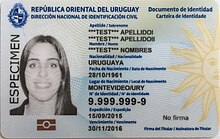Documento de Identidad (Uruguay)
In Uruguay, the "Documento de Identidad," before known as "Cédula de identidad", is delivered by the Ministry of the Interior and the National Directorate of Civil Identification (DNIC) to the people. Everyone in Uruguay has to have this card for different things they need to do, whether it's with the government or private companies. This rule applies to everyone living in Uruguay, whether they were born there, became a citizen, or are just living there temporarily or permanently. Even babies who are 45 days old or older need to have this ID card.
Characterictics[change | change source]
Old Cédula de Identidad[change | change source]

Before 2015, the original name was "Cédula de identidad." It was a small card, about 9 cm wide and 5 cm tall, mostly light green in color. In the middle, it had the flag of the Thirty-Three Orientals with the words "Libertad o muerte." On the other side, there was a photo of the person, a unique number given by the D.N.I.C. (with a self-generated or verification digit), their full name and last names, and their signature (or a note if they couldn't sign).[1][2]
The back of the card had information like nationality, date of birth, when the card was given, and when it would expire (usually 10 years after it was issued, but if you got it after you turned 70, it was valid for life, and for kids, it was valid for five years). It also had a thumbprint of the right thumb and any important notes. Since 2010, it also had a photo and a barcode.
People use this ID card for all sorts of things, like buying stuff with credit cards, proving who they are, showing their age, and more.
Name modifcation and new electronic style[change | change source]

In 2015, Uruguay's ID card went through some big changes to make it more secure. It stopped

being called the "Cédula de identidad" and became the "Documento de identidad."
The new ID card is made of a tough material called polycarbonate and is engraved with lasers. This makes it last for 10 years and stops people from erasing or changing the information because the laser burns the polycarbonate. It also has translations into Portuguese for words like "Apellido/Sobrenome" (Surname), "Nombre/Nome" (Name), "Vencimiento/Vencimento" (Expiry date), and others.[3]

It has three levels of security:
- Can be seen in a microscope. These include tiny text and holograms that glow under UV light.
- There are secret security features that only the D.N.I.C. knows about and need special equipment to check.
The adult ID card has two chips:
- One chip you can see and touch, which has electronic travel info. It's like an electronic passport, but it can't replace a real passport. It works in some South American countries, and can be used use it at certain airport gates.
- The other chip is invisible and works without contact. It helps with electronic identification and can be used for many electronic services, both government and private. The user can read the information, compare your fingerprint to the data on the card to make sure it's you, and it has keys and a certificate for secure electronic stuff.
For foreigners, the ID card is yellow and says "Extranjero" (Non-citizen) on it.
But, for naturalized citizens (people who became Uruguayan citizens), have an issue. Their ID cards don't follow international rules (ICAO 9303-3 7.1) because the D.N.I.C. lists the place where they were born instead of saying they are "Uruguayan." This can cause issues at airport gates and with immigration in other countries because it doesn't match up.
Minor's ID have no chips.
Abroad use[change | change source]
People who have the Uruguayan ID Document can go to all the countries in the Mercado Común del Sur (Mercosur) without needing a passport. There are nine countries in South America where this rule applies.
Related pages[change | change source]
References[change | change source]
- ↑ El País (17 March 2010). "Nueva cédula de identidad tendrá código de barras". Uruguay. Archived from the original on 6 September 2010. Retrieved 18 February 2012.
- ↑ 180 (20 March 2010). "Modifican cédula buscando más seguridad". Uruguay. Retrieved 18 February 2012.
{{cite web}}:|author=has numeric name (help) - ↑ El País (4 May 2015). "nuevo sistema para la cédula de identidad". Uruguay. Retrieved 20 May 2015.
